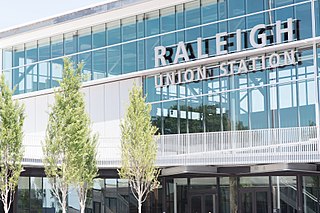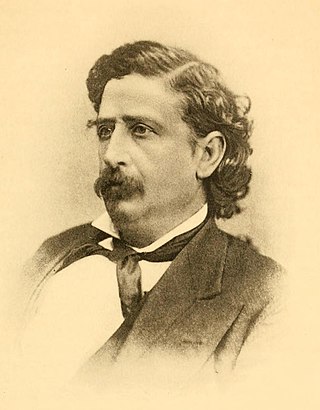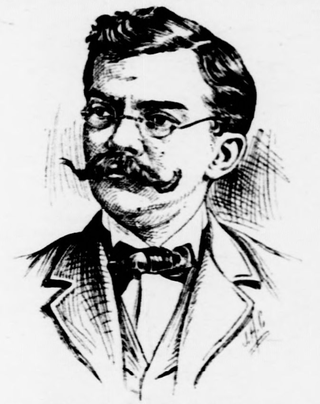Related Research Articles

William Walton Kitchin was an American attorney and the 52nd governor of the U.S. state of North Carolina from 1909 to 1913.

U.S. Route 701 is an auxiliary route of US 1 in the U.S. states of South Carolina and North Carolina. The U.S. Highway runs 171.45 miles (275.92 km) from US 17 and US 17 Alternate in Georgetown, South Carolina north to US 301, North Carolina Highway 96, and Interstate 95 (I-95) near Four Oaks, North Carolina. US 701 serves the Pee Dee region of South Carolina and the southern and central portions of Eastern North Carolina. The highway connects Georgetown and Conway in South Carolina with the North Carolina cities of Whiteville, Elizabethtown, Clinton, and a short distance north of its terminus, Smithfield. US 701 has four business routes in North Carolina, including those through Tabor City, Whiteville, Clarkton, and Clinton.

The Seaboard Air Line Railroad, known colloquially as the Seaboard Railroad during its time, was an American railroad that existed from April 14, 1900, until July 1, 1967, when it merged with the Atlantic Coast Line Railroad, its longtime rival, to form the Seaboard Coast Line Railroad. Its predecessor railroads dated from the 1830s and reorganized extensively to rebuild after the American Civil War, and by 1900 had merged together to form the SAL. The company was headquartered in Portsmouth, Virginia until 1958, when its main offices were relocated to Richmond, Virginia.

The Norfolk Southern Railway was the final name of a railroad that ran from Norfolk, Virginia, southwest and west to Charlotte, North Carolina. It was acquired by the Southern Railway in 1974, which merged with the Norfolk and Western Railway in 1982 to form the current Norfolk Southern Railway.

The South Carolina Rail Road Company was a railroad company that operated in South Carolina from 1843 to 1894, when it was succeeded by the Southern Railway. It was formed in 1844 by the merger of the South Carolina Canal and Rail Road Company (SCC&RR) into the Louisville, Cincinnati and Charleston Railroad Company. It was built with a track gauge of 5 ft.
The Aberdeen and Asheboro Railroad (A&A), known locally as "Page's Road," was the conglomeration of two previous railroads built by the Page family of Aberdeen, North Carolina, at the turn of the 20th century. The railroad ran 56 miles (90 km) to connect its namesake cities with a 20.75-mile long (33.39 km) branch connecting Biscoe to Troy and Mount Gilead and another branch connecting West End to Jackson Springs.

Raleigh Union Station is an intermodal transit station in Raleigh, North Carolina, United States. Train service began the morning of July 10, 2018. Its main building serves as an Amtrak train station, while a future adjacent building will serve as the bus terminus for GoTriangle. The station is located at the Boylan Wye, a railroad junction used by CSX and Norfolk Southern, and adjacent to the Depot Historic District in downtown Raleigh.
The Fast Mail was a Southern Railway mail and express train that operated between Washington, D.C., and New Orleans, Louisiana. The southbound Fast Mail carried the train number of 97, and was later known by the nickname of "Old 97". One such trip made by the train, on September 27, 1903, derailed at Stillhouse Trestle in Danville, Virginia, and was later known as the "Wreck of the Old 97", for which the service was most well known.

The Raleigh and Charleston Railroad was a Southeastern railroad that served eastern South Carolina and eastern North Carolina in the early 20th century.
The Charleston, Sumter and Northern Railroad was a South Carolina railroad that operated at the end of the 19th century.
The Northwestern Railroad of South Carolina was a South Carolina railroad that traced its history back to the 1880s and survived until the mid-1930s.

Joseph Florence Leitner was an American architect whose work includes several rail stations. In Columbia, South Carolina he worked for Charles Coker Wilson for five years. Later he partnered with William J. Wilkins (architect), first in Florence, South Carolina and then in an office in Wilmington, North Carolina, where Leitner practiced for a decade. to form Leitner & Wilkins. His work included commercial, educational, fraternal religious, industrial, residential, and transportation buildings in colonial revival architecture, Flemish architecture (especially gables, Italianate architecture and Romanesque revival architecture styles. He ended his career in Florida.

North Carolina Highway 21 (NC 21) was a primary state highway in the U.S. state of North Carolina. Originally, NC 21 began at the South Carolina state line west of Fair Bluff. The highway travelled north connecting Lumberton, Fayetteville, and Lillington before ending in Raleigh. By 1926, the highway was realigned south of Fayetteville, beginning in Whiteville and running north through Elizabethtown and Dublin before reaching Fayetteville. The highway was realigned once again in 1929, replacing NC 231 from Elizabethtown to U.S. Route 17/NC 20 near Delco and being routed north of Raleigh to US 15/NC 75 Creedmoor.

Edwin Warren Moïse was a Jewish-American lawyer, Confederate officer, and Adjutant-General from South Carolina.
Max Warley Platzek was a Jewish-American lawyer and judge.

Hal W. Ayer was an American newspaper editor and politician who served as chairman of the North Carolina People's Party executive committee from 1896 to 1897 and as North Carolina State Auditor from 1897 to 1901.
The Atlantic Coast Line Railroad's Florence—Robbins Line was one of the company's secondary main lines that ran from Florence, South Carolina to Robbins. It was built in the late 1800s and large parts of it were built by the Atlantic Coast Line's predecessor companies. Parts of the line are still in service.
References
- ↑ "Work on the Carolina Northern". The News & Observer. Vol. 47, no. 86. Raleigh, NC. December 21, 1899. p. 3.
Lumberton ... the general superintendent is located here permanently ...
- ↑ "Marion's Thriving Banks". The Sunday News. Charleston, SC. February 7, 1904. p. 4.
An immense quantity of lumber is hauled over this road
- ↑ "Carolina Northern Railroad". The News & Observer. Vol. 48, no. 88. Raleigh, NC. June 28, 1900. p. 6.
Two trains daily except Sunday...
- ↑ "Carolina Northern Railroad (timetable)". The News & Observer. Vol. 53, no. 119. Raleigh, NC. January 30, 1903. p. 8.
- 1 2 "Troubles of C.N.R.R. Company". The News and Courier. Charleston, SC. August 28, 1905. p. 2.
- 1 2 "Raleigh to Charleston". The News and Courier. Charleston, SC. October 25, 1905. p. 1.
The company is a reorganization of the old Carolina Northern Railroad ...
- ↑ "A Railroad Surprise". The Watchman and Southern. Vol. 18. Sumter, SC. July 5, 1899. p. 8.
- ↑ "Parallels its Rival". The Watchman and Southern. Vol. 18. Sumter, SC. July 12, 1899. p. 7.
- 1 2 "Sell The Railroad; Federal Court Orders This of Carolina Northern". The News & Observer. Vol. 57, no. 139. Raleigh, NC. August 19, 1905. p. 6.
- ↑ "Senate". The Progressive Farmer. Vol. 14. Raleigh, NC. February 21, 1899. p. 7.
... bills passed: ... to incorporate the Carolina Northern Railroad Company.
- ↑ "State News Items". The News & Observer. Vol. 46, no. 59. Raleigh, NC. May 19, 1899. p. 4.
Work has begun in earnest and will be prosecuted as rapidly as possible.
- ↑ "The Carolina Northern". The News & Observer. Vol. 46, no. 131. Raleigh, NC. August 11, 1899. p. 2.
Eight car loads of steel rail ... the first consignment ... arrived Friday. ... weighing 60 pounds to the yard ...
- ↑ "Among the Railroads". The News & Observer. Vol. 51, no. 69. Raleigh, NC. December 1, 1901. p. 13.
The first train being run ... yesterday
- ↑ "(untitled)". The News & Observer. Vol. 51, no. 67. Raleigh, NC. November 29, 1901. p. 5.
The Carolina Northern Railroad is ... a tangible fact. Its trains are now running...
- 1 2 3 "Marion, SC to Lumberton, NC". Abandoned Rails.
- ↑ "From Marion to Charleston". The News and Courier. Charleston, SC. September 4, 1901. p. 5.
There is talk here that the Carolina Northern Railroad may eventually be built to Charleston...
- ↑ "Among the Railroads". The News & Observer. Vol. 51, no. 117. Raleigh, NC. January 28, 1902. p. 5.
... the Carolina Northern Railroad will be extended from Lumberton to Fayetteville, and from Marion, S. C., to Charleston.
- ↑ "(untitled)". The News & Observer. Vol. 51, no. 145. Raleigh, NC. March 1, 1902. p. 5.
...the consequent construction of a through line from Raleigh to Charleston.
- ↑ "Shortage of Cars Causes Trouble; Receiver Is Named for Three Big North Carolina Concerns". The Houston Chronicle and Herald. Houston, TX. Associated Press. December 2, 1902. p. 1.
... the Carolina Northern Railroad ... placed in the hands of Receiver Augustus Meller ...
- ↑ Coleman, Alan. "The P&W Supplement to Railroads of North Carolina". Piedmont & Western Railroad Club and Old Rock School Railway Museum. Archived from the original on February 12, 2007.
- 1 2 "R. & C. Railroad to Cease Operation". The Charleston Evening Post. Charleston, SC. June 27, 1941. p. 23.